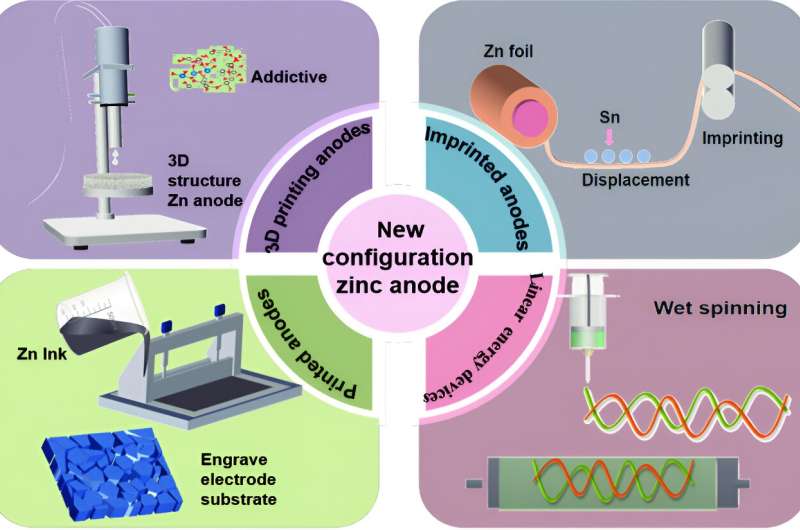This article has been reviewed according to Science X's editorial process and policies. Editors have highlighted the following attributes while ensuring the content's credibility:
fact-checked
proofread
The many faces of a zinc anode: Configurations can make a difference in performance

Sometimes the solution to a problem can be as simple as changing the way the components are structured. Researchers have proposed a reconfiguration of zinc anodes, a component of renewable energy sources, to help improve the battery and reduce the reliance society has on fossil fuels. The potential that different configurations of a zinc anode can have could reduce costs and side reactions while increasing the safety of the rechargeable zinc metal battery (RZMB) and, of course, improve its "green" rating.
The results were published in Energy Materials and Devices.
Rechargeable zinc metal batteries (RZMBs) are promising forms of energy storage devices, both for wearable and traditional storage technologies. The conventional zinc foil anode is not conducive to flexible and wearable technology, which is an ever-present form of tech in many people's lives. Therefore, altering and adjusting the RZMBs to accommodate the emergence of newer tech, as well as improving upon more traditional battery storage, is a must.
"With the continuous development of RZMBs, electrode materials need to be diversified to suit practical application scenarios," said Guozhao Fang, author and researcher of the study.
While zinc anodes are a good solution, they're still hindered by some of their side reactions. These reactions include the formation of dendrites, or root-like projections of metal, that can lead to a battery shortage, corrosion, and other issues impeding the function and longevity of the battery.
The review researchers put forth on the different configurations of zinc anodes aims to reduce these issues while also offering a lower cost. The configurations proposed in this review include: a 3D Zn anode, a 3D printed Zn anode, a printed Zn anode, imprinted Zn anode and a linear Zn anode.
A 3-dimensional Zn anode can help reduce the formation of Zn dendrites thanks to a larger specific surface for the ions to diffuse. 3D printing these structures can make the process of producing these structures cost-effective without sacrificing precision.
The function of the imprinted Zn anode can help reduce the aggregation of zinc ions by utilizing a gradient for conductivity and hydrophilicity (the ability to interact with water or "water-loving") to reduce ion deposition. Printed and linear anodes can be effective when it comes to flexible and wearable technology, with linear anodes utilizing a zinc fiber-like battery and printed anodes using an engraved electrode pattern on self-adhesive paper.
The adhesive is then applied to a substrate, which can include wood, skin, paper, or glass.
"The design and optimization of new configuration anodes can significantly improve the performance of RZMBs, including increasing energy density, extending cycle life, and improving power density, which promotes the commercialization of next-generation RZMBs," said Fang.
For this to be applicable in a range of technologies and available widely for use, the designs need to be optimized. This would include further research into how the various RZMBs would interface with the electrolyte to ensure safety and chemical stability.
The substrates also need to be suitable: ideally, they should have sufficient stability to withstand zinc stripping and electroplating, the ability to maintain their structure, resistance against corrosion, and good zinc attraction (zinciphilicity) for proper and uniform Zn ion deposition.
Furthermore, there's the possibility new electrolytes would need to be looked into to accompany different zinc anode configurations. By optimizing the electrolyte and the zinc anode, an improvement in the ionic transport rate and therefore overall function of the battery can be achieved.
More information: Yajue Zhang et al, Advances on new configuration of zinc anode towards high-performance emerging zinc-based electronic devices, Energy Materials and Devices (2024). DOI: 10.26599/EMD.2023.9370023
















